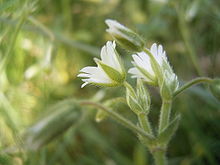Cerastium fontanum
| Cerastium fontanum | |
|---|---|
 |
|
| Scientific classification | |
| Kingdom: | Plantae |
| (unranked): | Angiosperms |
| (unranked): | Eudicots |
| (unranked): | Core eudicots |
| Order: | Caryophyllales |
| Family: | Caryophyllaceae |
| Genus: | Cerastium |
| Species: | C. fontanum |
| Binomial name | |
|
Cerastium fontanum Baumg. |
|
Cerastium fontanum, also called Mouse-ear chickweed, Common mouse-ear, or Starweed is a species of mat-forming perennial or, rarely, annual plant. It is native to Europe but introduced elsewhere. Mouse-ear chickweed's identifying characteristics are tear-shaped leaves growing opposite one another in a star pattern, hairy leaves, and small white flowers. Mouse-ear chickweed typically grows to 4"-8" tall vertically and spreads horizontally along the ground via the formation of roots wherever the stem falls over and contacts the ground.
Cerastium fontanum is a low growing plant covered with small hairs which are not sticky, that is without glandular tips. The erect flowering stems up to 45 cm long and leaves, opposite, up to 20 mm long without stalks. It has prostrate branches which do not bear flowers. The petals are shorter than the sepals or a little longer and are deeply divided. The flowers have 10 stamens with 5 styles.
Common in grassland, roadsides.
Common throughout Great Britain and Ireland.
...
Wikipedia
